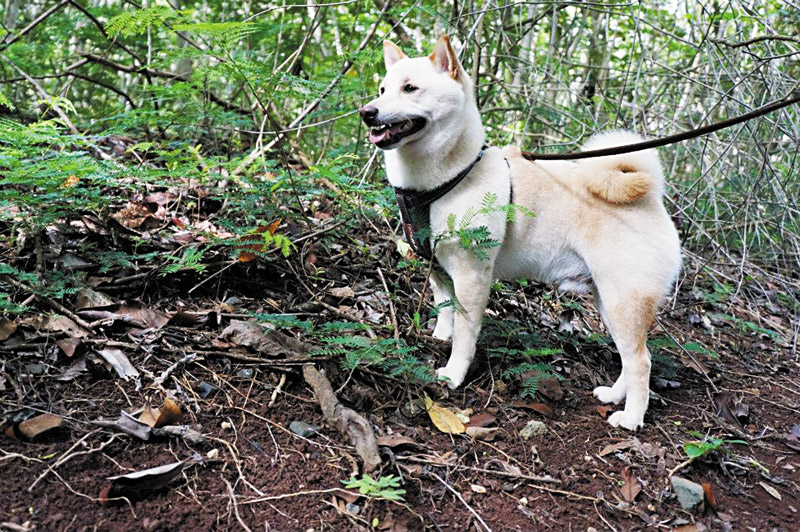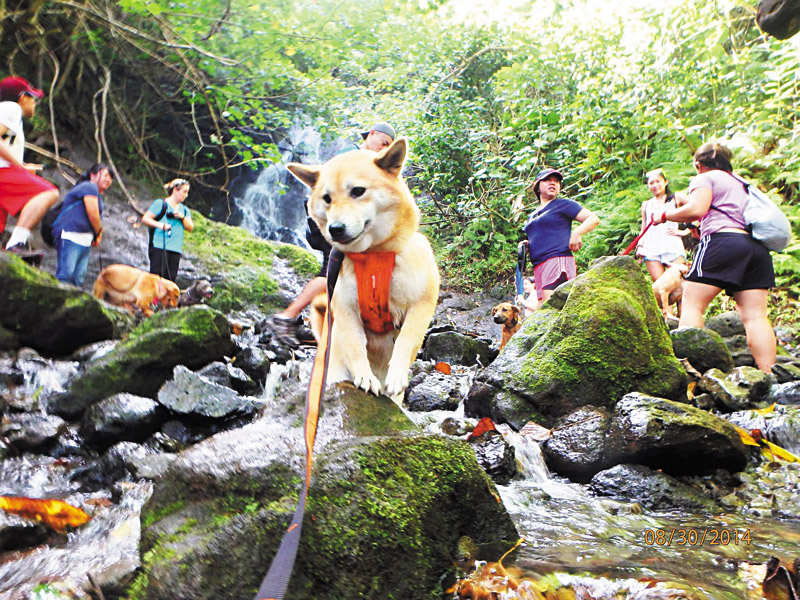EASY TRAILS MAKE FOR HAPPY TAILS

(Above) Rocky takes a break while hiking Likeke Trail with Humane Society’s Paws on the Path Hiking Club. (Below) Miki explores along Likeke MIKE YAMAGUCHI PHOTOS
BY CAITLIN BASILIO
With the recent record-breaking heat throughout the state, the Veterinary Emergency + Referral Center of Hawaii (VERC) already has had five dogs brought in for heatstroke this summer alone – and only one of them has survived. Vets will do everything possible to make sure pets are healthy, using updated medical equipment such as https://www.butterflynetwork.com/vet/iq-vet to treat them, however, they can’t fight this alone and owners must take care of their pets during high temperature months
There is such a thing as too much fun in the sun for dogs: Four out of five of those heatstroke cases happened while hiking or walking. As VERC emergency veterinarian Erin McNally explains, dogs suffer from heatstroke more easily than humans because it takes a lot of work for them to cool down.
“They can’t sweat, except the pads of their feet, so they’re reliant on panting,” McNally says. “And if the outdoor temperature is already hot and humid, then their panting is going to be a lot less effective, which means that they’re going to get much higher body temperatures.”
Even after a dog’s heat stroke is treated, they still are at risk for more complications – like kidney failure, vomiting, and diarrhea.
“It’s a vicious cycle,” adds director of emergency medicine Will Coleman.
But that doesn’t mean you can’t bring your pet on your next hike; you just need to be prepared. Also, keep in mind that your dog cannot communicate, so it is your responsibility to keep track of how he is doing. Do not try to drag things if he does not appear to be in good health. As a preventative measure, take your dog to a vet in your area on a regular basis for a checkup. This may ensure that, even if he does have some issues, they are identified at an early stage. You can learn more here about vet care and how it can benefit your dog. You could also check out their interesting blog posts about pets.
To help dog owners take proper precautions, Coleman and McNally share some advice.

Bring lots of food and water.
Your dog needs food if they’re gonna keep up with you for the whole trek. Try to read the farmer’s dog reviews and about other popular brands so you can pick the most suitable one for your dog. This food should help them stay active throughout the day.
After that, remember to keep a surplus of water. This is not only for your dog to drink, but you should bring enough water to periodically wipe them down.
“If your dog starts (panting or getting tired), get them into the shade, give them water and wet them down,” advises Coleman.
If your dog’s condition doesn’t improve, carry them off the trail and get them to a vet as soon as possible.
Hike in the early mornings or evenings when it’s cooler.
“Even if you think your dog is athletic, don’t hike past 9 a.m. or before 7 p.m. in the summertime – it’s just crazy,” says McNally.
Choose your trail wisely.
Hike on valley trails with lots of shade, or along waterways so dogs can hop into the water to cool off.
You also should gauge the steepness of the trail before heading out.
“Dogs are usually very athletic, but you have to think about if there are ropes on the trail a human might use … to scurry up a set of steeper rocks. Dogs can’t really do that,” explains McNally.
Also, McNally advises that paved roads are not ideal, as they’re harder on Fido’s feet.
“As much as (dog’s) feet are different from ours, they’re not wearing shoes,” McNally explains. “If they’re not used to it, it definitely is going to tear their paws up.”
HAPPY TRAILS TO YOU
One of the trails McNally recommends is Manoa Falls. Located toward the back of Manoa Valley, Manoa Falls is an easy one-mile hike. The lush trail winds through a series of towering Eucalyptus trees and small streams, ending at a waterfall.
That one also is a favorite for Mike Yamaguchi, who regularly hikes with Hawaiian Humane Society’s Paws on the Path Hiking Club, a group for pooches and their people that meets monthly.
“There are trees overhanging, so there is some shade,” says Yamaguchi, who takes his Shiba Inu, Mikie, on Paws on the Path outings. “It’s uphill, but not too steep, and the ground has small stones so if it rains, it’s not muddy.”
For any hike, it’s important to know your animal’s limits. For more athletic dogs (and experienced owners), McNally suggests Kuliouou Ridge Trail in Hawaii Kai. It’s about four miles round trip, but, as McNally points out, most of it is shaded. Be warned, though, that the incline can be steep in certain spots, and the last stretch of the trail is open.
For beginners, flat and shady paths are always a safe route – like Likeke Trail in Kaneohe, which is one of Yamaguchi’s top picks. He likes that it ends in a small waterfall and has many other attractions along the way:
“If dogs love the water, Likeke is the trail for them,” Yamaguchi says. “I also see that they like the tall grass to jump inside and run around in there. Taking dogs on hikes gives us entertainment just to watch them have fun.”
For more information on how your dogs can beat the heat, contact Veterinary Emergency + Referral Center of Hawaii at 735-7735. The American Society for the Prevention of Cruelty to Animals also has some tips at aspca.org.
For more on Paws on the Path Hiking Club, call 356-2222 or visit hawaiianhumane.org/dog_ hiking. Its next hike is scheduled for Aug. 29 at Likeke Trail.

